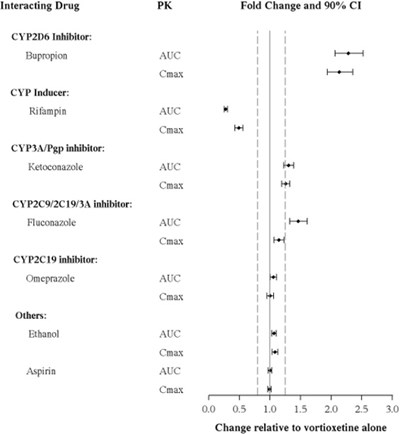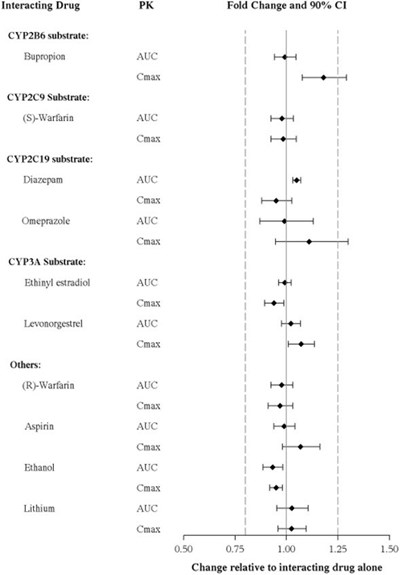Product Images Trintellix
View Photos of Packaging, Labels & Appearance
Product Label Images
The following 13 images provide visual information about the product associated with Trintellix NDC 64764-720 by Takeda Pharmaceuticals America, Inc., such as packaging, labeling, and the appearance of the drug itself. This resource could be helpful for medical professionals, pharmacists, and patients seeking to verify medication information and ensure they have the correct product.
Figure 2 - trintellix 02

This text appears to be a table listing population descriptions along with test and reference age, race, and various medical impairments including renal and hepatic. The table also includes PK (pharmacokinetic) parameters such as AUC and Cmax, as well as a fold change and 90% confidence interval. There are also numerical values listed for AUC and Cmax with some reference to a change relative to the reference.*
Figure 3 - trintellix 03

This text contains information about drugs that interact with certain enzymes like CYP2D6, CVP inducer, CYP3A/Pgp inhibitor, CYP2C9/2C19/3A inhibitor, and CYP2C19 inhibitor. It also mentions other substances like ethanol and aspirin. The text includes a chart with fold change and 90% CI related to vortioxetine alone.*
Chemical Structure - trintellix 04

This is a list of drugs classified based on their interaction with certain liver enzymes (CYP2B6, CYP2C9, CYP2C19, and CYP3A). The list includes Bupropion, (S)Warfarin, Diazepam, Omeprazole, Ethinyl estradiol, Levonorgestrel, (R)-Warfarin, Aspirin, Ethanol, and Lithium. Additionally, the list contains some Pharmacokinetic (PK) parameters such as AUC, Cmax, AUC.Cmax, AUC.Cmax.AuC, Fold Change, and 90% Confidence Interval. However, the information is not structured or complete enough to provide a practical description.*
Figure 4 - trintellix 05

This is a partial text containing medication names and dosage levels along with a table of numbers representing study visit weeks. The text is not complete and does not provide enough information to generate a useful description.*
Figure 5 - trintellix 06

This is a description of different studies that evaluated the efficacy of different doses of TRINTELLIX in individuals. Study 1, 2, and 3 were conducted outside of the US while studies 4, 5, and 6 were conducted in the US and outside of the US. Doses varied from 5mg to 20mg among the different studies. The text includes a graph that shows the difference from placebo, with positive values indicating better performance than placebo and negative values indicating worse performance than placebo. No further information is available.*
Figure 6 - trintellix 07

The text appears to be a chart showing the percentage of patients with recurrence over time, with two groups: one group taking Trintellix (at either 5 or 10 mg) and another group taking a placebo. The chart indicates the number of patients maintained at each time point, with time measured in weeks.*
PRINCIPAL DISPLAY PANEL - 5 mg Tablet Bottle Label - trintellix 08

This appears to be a chart showing the time to recurrence of a medical condition in patients who were given either TRINTELLIX at different dosages or a placebo. The chart shows the number of patients maintained, the time to recurrence in weeks (0-32), and the proportion of patients with recurrence at each time point.*
PRINCIPAL DISPLAY PANEL - 10 mg Tablet Bottle Label - trintellix 09

This appears to be a comparison chart for two medications, Trintellix and Escitalopram, with dosages of 10 or 20mg. The chart measures improvement from baseline at different study visits, but without further context, it is not possible to determine the specific nature of the study or the results.*
trintellix 10

This appears to be a medical report or data showing a comparison between different medications. The medications mentioned are Trintellix 10mg and 20mg, Placebo, and Paroxetine 20mg. The report possibly shows a change or comparison from Basel and the worsening of symptoms. However, without context, it is impossible to accurately interpret the text.*
PRINCIPAL DISPLAY PANEL - 20 mg Tablet Bottle Label - trintellix 11

The text appears to be a medication label for a drug called TRINTELLIX, which contains vortioxetine hydrobromide (equivalent to 5 mg vortioxetine) and is intended for prescription use only. The label advises against accepting a bottle with a broken or missing seal and recommends consulting the accompanying Medication Guide before use. The usual dosage is included in the package insert, and the drug should be stored at a controlled room temperature. The label also includes trademark and distribution information for H. Lundbeck A/S and Takeda Pharmaceuticals America, Inc.*
trintellix 12

This is a description of a medication called Trintellix. The label warns that the bottle's seal should not be accepted if it is broken or missing. The medication contains 10 mg of vortioxetine hydrobromide and it is recommended to refer to the package insert for dosage information. Trintellix is manufactured by Lundbeck in Deerfield, IL and marketed by Takeda Pharmaceuticals America in Lexington, MA. The medication should be stored at room temperature. There is also a code listed as "59 Cakeddy -2+" which is not clear how it is related to the medicine.*
trintellix 13

Tamper-evident instructions for a medication bottle containing red tablets with vortioxetine hydrobromide equivalent to 20 mg vortioxetine. Dosage information is located in the package insert. The bottle contains 30 tablets and has an NDC code of 64764-750-30. It should be stored at 25°C (77°F) with excursions allowed between 16-30°C (50-86°F). The bottle is manufactured by Takeda Pharmaceuticals America, Inc. and the tablets are processed by Lundbeck. TRINTELLIX is a registered trademark of H. Lundbeck and is used under license by Takeda Pharmaceuticals America. No further information is available.*
* The product label images have been analyzed using a combination of traditional computing and machine learning techniques. It should be noted that the descriptions provided may not be entirely accurate as they are experimental in nature. Use the information in this page at your own discretion and risk.
